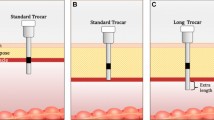Abstract
Background
We set out to design a bowel retractor for use during laparoscopic transperitoneal reconstruction of the infrarenal aorta and of both iliac axes.
Methods
This study was performed on five cadavers. After the insertion of four trocars, a pneumoperitoneum was created, and the bowels were gathered to the right flank. On each cadaver, the following four measurements were made: the distance between the Treitz angle and the aortic bifurcation (L1), the distance between the aortic bifurcation and the right internal inguinal ring (L2), the angles between L1 and L2 in the axial plane (A1), and the angles between them in the sagittal (A2) plane. These measurements enabled us to create a bowel retractor. The device was composed of a malleable metallic rod with a 2.5-mm diameter that was fixed to the operating table and whose intraabdominal section was designed to follow the outline of the mesenteric root in addition, a 25×12 cm polypropylene net was slipped around the rod. The infrarenal aorta and both iliac axes were then dissected. Secondarily, the bowel retractor was used in eight patients (seven men and one woman; mean age, 56 years; range 44–76) during laparoscopic aortoiliac reconstruction for occlusive (n=6) or aneurysmal (n=2) disease.
Results
The statistical analysis of the measurements performed on cadavers showed a significant correlation between body height and L1 (r=0.8769; p<0.05) and L2 (r=0.9706; p<0.01) distances. It was then possible to design the shape of two metallic rods (one small and one large) so that they would be adaptable to the height of the patients (<1.65 m and >1.65 m). During our clinical experience, all laparoscopic procedures were completed in a mean operative and clamping time of 266 min (range, 215–360) and 54 min (range, 18–90), respectively. Mean postoperative hospital stay was 6 days (range, 3–13).
Conclusion
Our experimental study allowed us to develop a bowel retractor that can make it easier to perform laparoscopic transperitoneal aortoiliac reconstruction in humans.
Similar content being viewed by others
References
Ahn SS, Clem MF, Braithwaite BD, Concepcion B, Petrik PV, Moore WS (1995) Laparoscopic aortofemoral bypass: initial experience in an animal model. Ann Surg 222: 677–683
Alimi Y, Hartung O, Lonjon T, Barthares P, Cador L, Juhan C (2000) Laparoscopic abdominal aortic replacement with left renal artery reimplantation: experimental study on pigs. Ann Vasc Surg (in press)
Alimi YS, Hartung O, Orsoni P, Juhan C (1999) Abdominal aortic laparoscopic surgery: retroperitoneal or transperitoneal approach? Eur J Vasc Endovasc Surg 19: 21–26
Alimi Y, Orsoni P, Hartung O, Berdah S, Lonjon T, Cador L, Picaud R, Juhan C (1998) Laparoscopic substitution of the abdominal aorta: experimental study in the pig. J Mal Vasc 23: 191–194
Barbera L, Mumme A, Mentin S, Zumtobel V, Kemen M (1998) Operative results and outcome of 24 totally laparoscopic vascular procedures for aortoiliac occlusive disease. J Vasc Surg 28: 136–142
Bosch JL, Hunning MGM (1999) Meta-analysis of the results of percutaneous transluminal angioplasty and stent placement for aortoiliac occlusive disease. Radiology 204: 87–96
Bruns CJ, Wolfgarten B, Kasper M, Zenner D, Walter M, Mannich B (1998) Gasless videoendoscopic implantation of aortobifemoral vascular prostheses via transperitoneal versus extraperitoneal approach in an animal model. Surg Endosc 12: 137–141
Dion YM, Gracia CR (1997) A new technique for laparoscopic aortobifemoral grafting in occlusive aortoiliac disease. J Vasc Surg 26: 685–692
Dion Y-M, Hartung O, Gracia CR, Doillon CJ (1999) Laparoscopic end-to-end aortobifemoral bypass with reimplantation of the inferior mesenteric artery: an experimental study. Surg Endosc 13: 449–451
Dion YM, Katkouda N, Rouleau C, Aucoin A (1993) Laparoscopically assisted aortobifemoral bypass. Surg Laparosc Endosc 3: 425–429
Edoga JK, Asgarian K, Singh D, James KV, Romanelli J, Merchaur S, Romano D, Joostema B, Street J (1998) Laparoscopic surgery for abdominal aortic aneurysm: technical elements of the procedure and a preliminary report of the first 22 patients. Surg Endosc 12: 1064–1072
Fabiani JN, Mercier F, Carpentier A, Le Bret E, Renaudin JM, Julia P (1997) Video-assisted aortofemoral bypasses: results in seven cases. Ann Vasc Surg 11: 273–277
Hartung O, Alimi Y, Lonjon T, Barthares P, Cador L, Juhan C (2000) Thoracoscopic descending thoracic aorta to femoral artery bypass: an experimental study. Ann Vasc Chir (in press)
Jobe BA, Duncan W, Swanstrom LL (1999) Totally laparoscopic abdominal aortic aneurysm repair. Surg Endosc 13: 77–79
Kline RG, D’Angelo AJ, Chen MHM, Halpern VJ, Cohen JR (1998) Laparoscopically assisted abdominal aortic aneurysm repair: first 20 cases. J Vasc Surg 27: 81–88
Kolvenbach R, Delling O, Schwierz E, Landers B (1998) Reducing the operative trauma in aortoiliac reconstructions—a prospective study to evaluate the role of video-assisted vascular surgery. Eur J Vasc Endovasc Surg 15: 483–488
Nevelsteen A, Lacroix H, Suy R (1991) Aortofemoral Dacron reconstruction for aortoiliac occlusive disease: a 25-year survey. Eur J Vasc Surg 5: 179–186
Said S, Mall J, Peter F, Müller JM (1999) Laparoscopic aortofemoral bypass grafting: human cadaveric and initial clinical experiences. J Vasc Surg 29: 639–648
Zucker KA, Pitcher DE, Martin DT, Ford RS (1994) Laparoscopic-assisted colon resection. Surg Endosc 8: 12–18
Author information
Authors and Affiliations
Additional information
Online publication: 11 October 2000
Rights and permissions
About this article
Cite this article
Alimi, Y.S., Hartung, O., Cavalero, C. et al. Intestinal retractor for transperitoneal laparoscopic aortoiliac reconstruction. Surg Endosc 14, 915–919 (2000). https://doi.org/10.1007/s004640000260
Received:
Accepted:
Published:
Issue Date:
DOI: https://doi.org/10.1007/s004640000260




